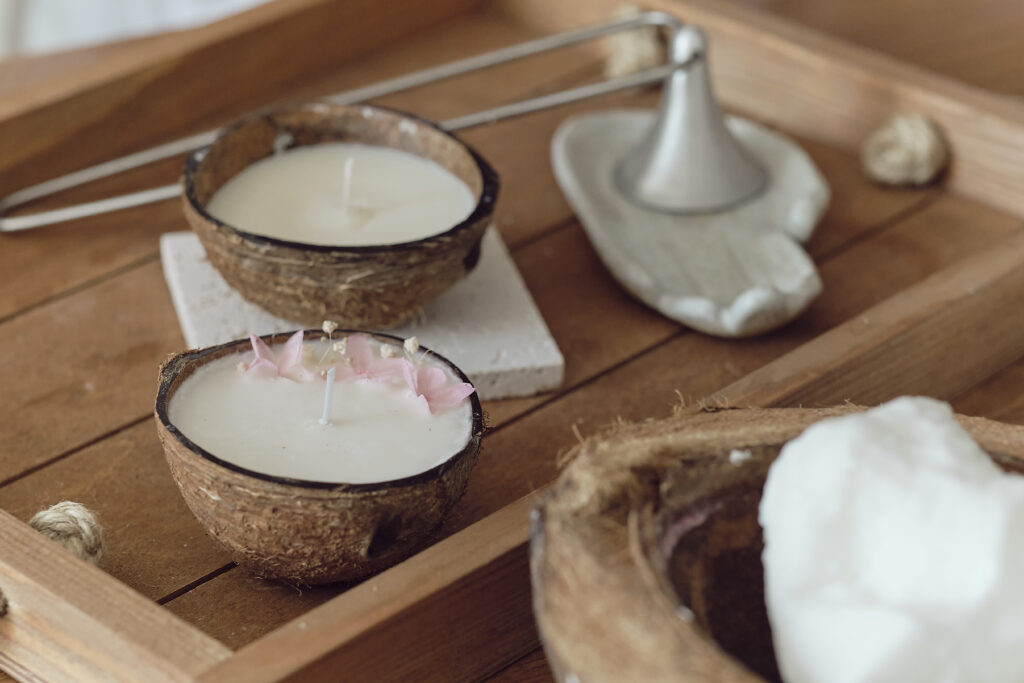Advanced Scent Blending Techniques in Candle Making

The art of candle making transcends beyond mere aesthetics; it’s an olfactory journey that can evoke memories, emotions, and create an ambiance. Mastering Scent Blending Techniques is essential for any candle maker looking to craft unique, aromatic candles. This guide delves into the intricacies of scent blending, offering insights into creating bespoke fragrances that captivate and enchant.
The Basics of Scent Blending
Scent blending in candle making is akin to creating a symphony, where each note must harmonize with the others. Understanding the basics is the first step in this creative process.
- Top Notes: These are the initial scents that hit the nose. They are usually light and evaporate quickly.
- Middle Notes: Also known as the “heart notes,” these form the main body of the fragrance.
- Base Notes: These scents linger the longest and provide depth to the fragrance.
Choosing the Right Fragrance Oils
Selecting high-quality fragrance oils is crucial. Candlewic’s Fragrance Oils offer a diverse range, from Classic Standard Fragrances to Ultimate Bold options, providing a plethora of scents to experiment with.
Scent Blending Techniques for Candle Making
Determining the Ideal Ratio for Fragrance Blends in Candle Making
When it comes to creating fragrance blends for candles, one of the most crucial aspects to consider is the ratio of fragrance oil to wax. This ratio not only impacts the strength and throw of the scent but also the overall performance of the candle. Understanding and applying the right ratio is key to crafting a candle that is both aromatic and burns effectively.
Basic Guidelines for Fragrance Oil to Wax Ratio
The general rule of thumb in candle making is to use a fragrance oil to wax ratio ranging from 6% to 10%. This means for every 100 grams of wax, you would add 6 to 10 grams of fragrance oil. However, this ratio can vary based on several factors:
- Type of Wax: Different waxes have different fragrance oil capacities. For instance, soy wax typically holds less fragrance oil compared to paraffin wax.
- Strength of Fragrance Oil: Some fragrance oils are more potent than others. Stronger scents may require a lower percentage to achieve the desired aroma intensity.
- Desired Scent Throw: If you want a more subtle scent, you might use a lower percentage of fragrance oil. For a stronger scent throw, you might increase the percentage within the recommended range.
Calculating the Exact Amount
To calculate the amount of fragrance oil needed for your candle, use the following formula:
Amount of Fragrance Oil (in grams)=Amount of Wax (in grams)×Percentage of Fragrance OilAmount of Fragrance Oil (in grams)=Amount of Wax (in grams)×Percentage of Fragrance Oil
For example, if you have 500 grams of wax and want to use an 8% fragrance oil ratio:
500 grams of wax×0.08=40 grams of fragrance oil500 grams of wax×0.08=40 grams of fragrance oil
Tips for Successful Scent Blending
- Test in Small Batches: Before committing to a large batch, test your fragrance blend in a small quantity of wax to ensure the scent throw and burn quality meet your expectations.
- Consider the Maximum Load: Each type of wax has a maximum fragrance load it can hold. Exceeding this limit can cause issues like poor burning or fragrance seepage.
- Adjust Based on Feedback: The perfect fragrance blend is often subjective. Adjust the ratio based on your preferences or the feedback from others.
- Safety First: Ensure that the total amount of fragrance oil used is safe for burning. Too much fragrance oil can lead to issues like sooting or flaring.
Final Thoughts
The ratio of fragrance oil to wax is a critical factor in candle making. It requires a balance between achieving the desired scent strength and ensuring the candle burns cleanly and safely. By following these guidelines and through experimentation, you can master the art of scent blending and create beautifully fragranced candles.
1. Understanding Scent Profiles
- Research: Familiarize yourself with various scent profiles and how they interact.
- Experimentation: Don’t be afraid to experiment by blending different oils. Sometimes, unexpected combinations can yield delightful results.
2. Balancing Scents
- Proportion: Start with a 1:1 ratio and adjust based on the strength of each oil.
- Complexity: Aim for a balance between simplicity and complexity. Too many scents can become overwhelming.
3. Seasonal Blending
- Holiday Scents: Blend warm, spicy notes for Holiday Fragrances, like cinnamon and clove for Christmas scents.
- Summer Scents: Opt for lighter, floral or fruity notes.
4. Thematic Blending
- Mood-Based: Create blends that evoke certain moods or feelings, like relaxation or invigoration.
- Occasion-Based: Consider the occasion, like a romantic dinner or a festive gathering, and blend scents accordingly.
Advanced Blending Tips
1. Layering Scents
- Technique: Add different scents at various stages of the candle-making process to create a layered effect.
- Outcome: This technique can result in a candle that reveals different scents over time.
2. Complementary Scents
- Pairing: Identify scents that complement each other, like floral with citrus, or woodsy with spicy.
- Outcome: These pairings can enhance the overall fragrance experience.
3. Testing and Refining
- Small Batches: Always test your blends in small batches before committing to larger quantities.
- Feedback: Get feedback from others to refine the scent blend.
The Role of Wax in Scent Blending
The type of wax used can significantly impact the scent throw of a candle.
- Soy Wax: Known for its clean burn and excellent scent throw, soy wax is a popular choice for scented candles.
- Beeswax: Offers a subtle, natural honey scent that can complement certain fragrances.
- Paraffin Wax: Highly versatile and can hold a higher fragrance load.
Discovering Harmonious Scent Combinations: What Pairs Well With Coconut?
The art of scent blending is not just about creating a fragrance but about evoking an experience. When it comes to pairing scents, understanding which aromas complement each other is key. Coconut, with its sweet, creamy, and tropical profile, offers a versatile base for numerous scent combinations. Let’s explore some of the most harmonious pairings for coconut and other scent combinations that are known to work well together.
Scents That Pair Well with Coconut
- Vanilla: The sweet, warm, and comforting notes of vanilla blend seamlessly with coconut, creating a rich and indulgent aroma. This combination often evokes a sense of tropical warmth and relaxation.
- Lime: The zesty and tangy notes of lime cut through the sweetness of coconut, offering a refreshing and invigorating scent. This pairing is reminiscent of a tropical beach cocktail.
- Pineapple: Another tropical companion, pineapple, brings a fruity and juicy element to the creamy coconut, creating a vibrant and summery fragrance.
- Sandalwood: For a more earthy and grounding experience, sandalwood pairs beautifully with coconut. The woodsy, deep notes of sandalwood complement the sweetness of coconut, adding a layer of sophistication.
- Musk: Musk adds depth and warmth to the light, tropical notes of coconut, resulting in a balanced and alluring scent.
Other Scent Combinations That Work Well Together
- Lavender and Eucalyptus: This duo is known for its calming and refreshing properties. Lavender’s soft floral scent combined with the sharp, clean aroma of eucalyptus creates a balanced and soothing fragrance.
- Rose and Patchouli: The classic floral scent of rose pairs elegantly with the rich, earthy notes of patchouli. This combination is often associated with luxury and sensuality.
- Cinnamon and Apple: A quintessential pairing that evokes warmth and comfort, perfect for creating a cozy atmosphere.
- Peppermint and Chocolate: This combination brings a refreshing twist to the rich, indulgent scent of chocolate, reminiscent of festive treats.
For more inspiration on delightful scent combinations and to explore some of the best-smelling candles available, check out this insightful article from New York Magazine: The Best-Smelling Candles, According to Experts.
In conclusion, the world of scent blending offers endless possibilities. Whether you’re pairing coconut with other tropical notes or exploring other aromatic duos, the key is to balance the strengths and characteristics of each scent to create a harmonious and appealing fragrance.
Conclusion
Scent blending in candle making is an art that requires patience, experimentation, and a keen sense of smell. By understanding the basics of fragrance notes, experimenting with different oils, and considering factors like wax type and scent throw, you can create perfumed candles that are truly unique and personal. Whether you’re crafting candles for personal use or for sale, mastering Scent Blending Techniques is a skill that will set your candles apart.




